Simple is Best. That’s an axiom that motorcycle manufacturers around the world are increasingly turning towards, as a counterpoint to the electronically driven technology race us riders currently find ourselves in.

BMW’s the latest big-name brand to jump on the Scrambler bandwagon. Does the ride live up to the hype?
“There are lots of people who want to get away from all that technology,” says BMW Motorrad’s Head of Design, Edgar Heinrich [see Interview]. “They want a cool style above all else, in a lower-performance package. We must try to provide that.”
A 250-mile two-day trip through the mountains and valleys of BeeEm’s beautiful Bavarian backyard and neighboring Austria, amply demonstrated the new Scrambler’s appeal as a practical but pleasurable ride with heaps of personality. Whereas the more performance focused original R nineT Roadster is mainly a bike for Sunday morning blasts along a racer road, its Scrambler sister is something you’ll look forward to riding any time you can on all kinds of roads—even in cities.
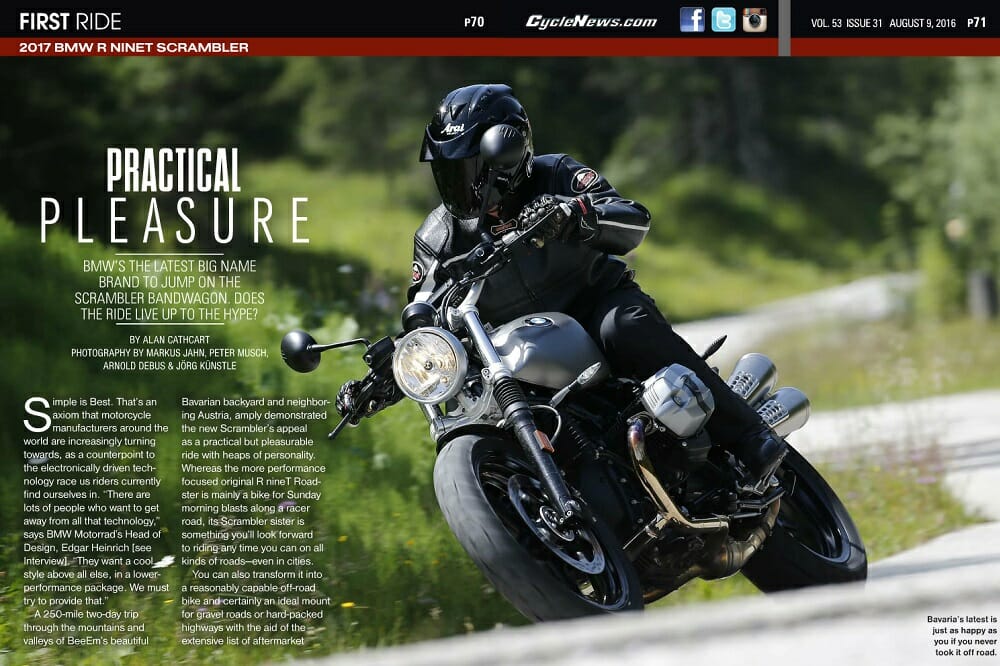
To read this in Cycle News Digital Edition Magazine, click HERE.
Photography by Markus Jahn, Peter Musch, Arnold Debus & Jӧrg Künstle
You can also transform it into a reasonably serious off-road bike and certainly an ideal mount for gravel roads or hard-packed highways with the aid of the extensive list of aftermarket options. These include wire-spoked rims and swapping the stock Metzeler Tourance Next street rubber for the German tire company’s Karoo 3 knobblies. BMW actually offers a ready-built accessorized version called the R nineT Scrambler X, with wire-spoked wheels, heated grips, LED indicators and the Karoo rubber.
The Scrambler comes with stock five-spoke cast aluminum wheels (with a 19-inch front for putative off-road use) instead of the Roadster’s wire-spoked rims, non-radial axially-mounted Brembo four-piston front brake calipers gripping a pair of 320mm discs, with a 265mm rear and twin-pot caliper, and switchable ABS as standard. Plus, there’s a non-adjustable 43mm conventional Showa fork with cool-looking rubber gaiters, compared to the Roadster’s upside-downer. But the Sachs monoshock operated by the single-sided swingarm’s Paralever linkage does have adjustable rebound damping and spring preload, and although it comes without the R nineT’s remote preload adjuster, it offers quite a bit more wheel travel at 140mm, with 125mm up front.

The fact that this is still some way down on the 190mm/200mm R1200GS numbers denotes this as being a street Scrambler when all said and done, albeit with some off-road capability after a visit to the aftermarket catalogue. There’s only a single seat and no pillion footrests or hangers as stock, though these are available as options, plus the 4.49 gal fuel tank is supposedly the same shape as before, except it’s a liter smaller than the Roadster’s aluminum tank but still provides a 160-mile range, and is made in less costly though heavier steel. In spite of that the Scrambler weighs in at 485lb fully fuelled and ready to go—4.4lb less than the original R nineT.
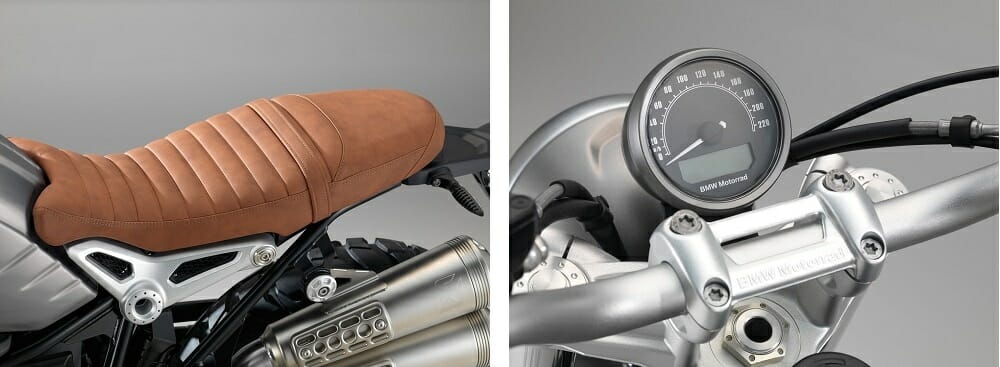
Same Heart, Different Body
The Scrambler is powered by the same neo-retro air/oil-cooled 1170cc Boxer twin engine measuring 101 x 73mm found in its sister bike, which, while still boasting a modern four-valves-per-cylinder DOHC format, has now been superseded by the more powerful Wasserboxer mill in the GS/R/RT Boxer model families. In spite of now being Euro 4 compliant thanks to revised engine mapping via the all-new Bosch BMS-MP ECU, a larger catalyst and a fuel system that now includes a carbon canister, it nevertheless produces the same 110 bhp at 7750 rpm as its Roadster predecessor that’s still only good for Euro 3, and gives just 2.2 lb-ft less torque with 85 lb-ft on tap at 6000 rpm.
That’s some achievement by BMW’s R&D team, since there are no mechanical differences between the two bikes’ motors, apart from what’s surely a further key factor in the Scrambler hitting the Euro 4 numbers with minimal loss in performance, and that’s the glorious-sounding high-level Akrapovič exhaust system it carries as stock. This retains the same headers as the R nineT, but with twin stacked pseudo-SuperTrapp silencers whose engagingly meaty and surprisingly loud droning exhaust note sounds a good deal more flat track than scrambler, and undoubtedly adds to the definite thrill you get from riding this motorcycle any place, any time.

Helping deliver this on the new Scrambler is an electric servomotor operating an acoustic valve via opening and closing desmodromic cables, which Akrapovič dreamed up to meet what BMW correctly identified as its customers’ desire for the sonorous Boxer sound to be retained and even amplified, while still meeting Euro 4 noise regulations. That tells you a lot about the ethos governing the development of this bike and the others coming next in the R nineT family—BMW didn’t need to get the Slovenian sultans of sound to make the Scrambler sound so good, because it could still have passed the Eurocrat sound tests without that.
But the whole idea about bikes like these is that they should be sensually stirring, fun to ride and evocative of tradition, and that’s exactly what the new Scrambler—and indeed the original R nineT, for which Akrapovič also produces the exhaust system—are all about.
However, the Scrambler badly needs the optional tacho that’s missing as standard, which apparently includes the gear-selected indicator that’s a must-have feature for a bike this torquey. I often found myself searching for a non-existent seventh gear, because with no way of knowing how many revs the engine was turning, and the fact that the droning exhaust note is unchanged irrespective of the revs, I couldn’t tell what gear the BMW was in, having lost track while shifting up. It’s a must-have option, but inevitably there’s a wide range of other accessories, from a titanium Akrapovic silencer to a windscreen, or heated grips, a headlamp grille, sump guard and a choice of luggage that includes a 4.4-gallon tank bag, and 10.5-gallon tail pack.
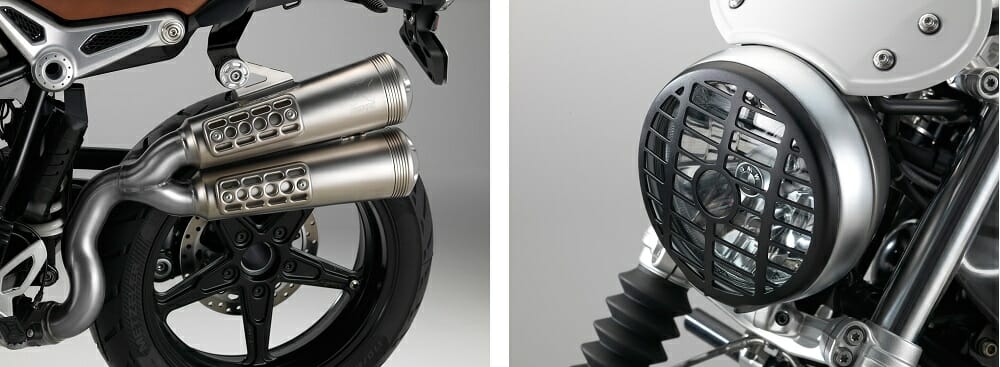
Not Ducati
Unlike the cheaper, less potent and frankly less substantial Ducati Scrambler with which it shares the moniker of the moment but not much else, the new BMW’s fueling is beautifully mapped all through the rev range in each ratio of its six-speed gearbox, without any of the Italian bike’s snatchy pickup from a closed throttle in the bottom two gears. That many ratios is pretty superfluous for something this torquey, and I often found myself sitting in fourth gear for mile after mile as I hustled the Scrambler through the switchback scenery of the Bavarian Alps, surfing the mile-wide torque curve and reveling in the flexibility of the oilhead Boxer motor.
It pulls cleanly away from a hairpin turn from very low revs, accepting wide open throttle in top gear on level ground from as low as 3000 rpm with zero transmission snatch, before coming on strong above 4500 rpm en route to its 7,750 rpm power peak. Its midrange punch is definitely impressive, and the Scrambler also felt pretty long-legged on faster stretches, making me all the more convinced of its touring potential, at least for a long weekend. It’s a mileater as well as a corner-carver.
A key element in that is the Scrambler’s extremely comfortable more upright riding position than the R nineT Roadster, with a taller 32.2-inch seat height versus the Roadster’s 30.9in, and the same one-piece handlebar mounted on 20mm taller risers that are also angled to pull the grips back further towards the rider. This not only delivers better leverage for hustling through hairpins up in the mountains, but also makes the Scrambler paradoxically at home in city traffic, where the upright stance lets you plot an untroubled course through snarl-ups, and its generous steering lock helps it to be surprisingly maneuverable at lower speeds in city streets.
You might not expect a bike called the Scrambler to be an ideal traffic tool, but that’s what the new BMW is, its crisp but controllable pickup coming to the fore when you ask it to. At 5’10” in height I found the Scrambler’s stance incredibly relaxed, the best riding position I’ve come across for a long time for my height, with the footrests lower and further to the rear than on the R nineT, coupled with that higher handlebar and an ideal seat height. It’s a pity that the Scrambler’s stitched brown leather-lookalike seat padding was so thin, though, resulting in numb-bum syndrome after a couple of hours sitting on it, though there’s a taller seat option which apparently has thicker padding.

Scrambled Bones
Mainly perhaps to make space for the 19-inch front wheel, the Scrambler has an all-new version of the R nineT’s modular frame concept, with its tubular steel frame endowed with more conservative geometry which includes a 28.5º rake for the Showa fork (against 25.5º), coupled with new triple clamps offering reduced offset for greater trail (4.35-inch vs. 4.03-inch), and a 60.1-inch wheelbase (57.8-inch). Those rangier numbers make the Scrambler super-stable and very predictable without being heavy-steering or slow to change direction, in spite of the 19-inch front wheel, which carries the same size 120/70 rubber as a normal 17-inch item, which you soon learn gives excellent grip on the angle.
The 170/60-17 rear tire is well chosen, providing good grip without requiring undue extra steering effort, and coupled with the good handlebar leverage this results in a very relaxed but surprisingly responsive handling package, with well-chosen settings for the non-adjustable Showa fork.
There’s satisfactory if not exceptional stopping power from the trio of discs gripped via steel lines, but you do need a good strong squeeze on the front brake lever—there isn’t a lot of modulation from the Brembo calipers. Wet-weather grip from the Metzeler Tourance Next tires was okay even in the occasional thundery deluge of Bavaria in summertime, though I was glad our test bikes had BMW’s optional ASC traction control fitted, which I could feel cutting in on slippery smooth soaked surfaces—it’s quite a basic system, but sufficiently functional to be worth having.
As an avid customiser in his time off from the day job, Edgar Heinrich has ensured that BMW R nineT Scrambler owners will be able to personalize their bikes both technically and visually. So the Scrambler’s frame comes as three separate component parts which have been bolted together using the Boxer engine as a fully stressed member—a front main section, a rear section with integrated end section, and a pillion subframe. As on the R nineT Roadster before it, the passenger frame on the Scrambler can be detached, allowing owners to change the look and thus the character of the bike according to personal taste. Furthermore, the wiring loom has the lighting system separate from everything else, so the owner can swap lights.
“I have this HP2 which I customized a bit,” says Edgar, “but it’s a pain to change anything on the electrics. Nothing works anymore, it goes to default lighting, it’s a nuisance—so we said okay, [on this bike] we have to make it very easy for the customer to exchange headlamps, blinkers, tail lights, anything like that. So we did!”
It’s a very astute policy, and seems certain to succeed. It’s Back to the Future, Boxer-style.
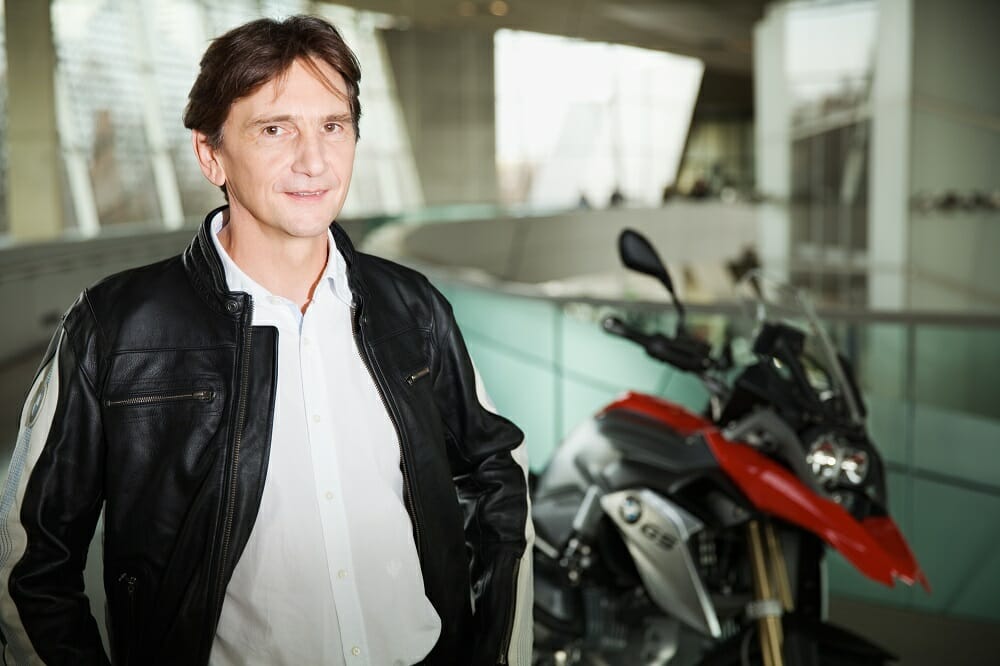
Edgar Heinrich Talks
Edgar Heinrich, 58, is BMW Motorrad’s Head of Design, and has spent most of his career working for the Bavarian-based company, with a first stint from 1986 to 2009. There, he was responsible for the styling of the then-radical four-cylinder K1200S and K1200R, the HP Megamoto off-road model, and the Paris-Dakar off-road racers. He also worked on creating the R1150GS and R1200GS two-wheeled cash registers which continue to represent BMW’s gateway to growth and profitability, and was head of the S1000RR Superbike design team.
But after the debut of that model in 2009, Heinrich moved to India, to become Vice President of Product Development at the country’s second largest manufacturer Bajaj Auto, where he worked alongside R&D engineers from its sister company KTM, today BMW’s rival for supremacy among European manufacturers. But in July 2012 Heinrich rejoined BMW Motorrad as Director of Design, in the wake of the abrupt departure of his predecessor David Robb. One of his first duties was to assume leadership of the team developing the R nineT retro model, and its succession of spinoff variants of which the new Scrambler is the first to reach the marketplace.
Edgar, how and why did the Scrambler come about?
It actually goes back quite some time ago to the original Lo-Rider concept we built in late 2007. This was the original Boxer Custom concept we did in Munich and was based on radicalizing old BMWs. The funny thing is that in the early 2000s, it was a complete sacrilege to chop an old air-cooled BMW about in any way—everybody thought these things were holy, so they had to be restored to perfection, and there were hardly any customized old BMWs in those days. Therefore the original idea with the Lo-Rider was to do this with a modern base, so we used the HB2 frame and engine to make a semi retro-styled low rider, which we showed at EICMA [Milan] in 2008.
Then I left BMW for a while, but when I came back there again from India in 2012, we wanted to do some bikes where the basic idea is not so much about design, but more about the emotional stuff you get from actually riding the bike, from running the engine up, from the vibrations, making burnouts, carving turns and so on. It was about making the dynamics a key part of the styling, meaning a bike that was cool to look at but great to ride. So when we wanted to do something for the 90 Year Anniversary of BMW, this is when we came up with the Concept 90, which was a BMW design that was built for us by Roland Sands in California, who’s been a big support in everything we do.
So was the Concept 90 actually your design, rather than Roland’s?
Of course, yes, it was always BMW designed, BMW created. But Roland executed the design for us—he’s been a friend of BMW’s for so long, and has always been the right guy for doing stuff like this.
So RSD in Los Angeles is like your BMW factory design studio’s back door?
Kind of, and you know one important thing about Roland? There’s lots of Custom guys out there, but whatever he makes is always performance orientated, and built to be ridden—and this of course is what we like at BMW. Because if we do a Custom, it has to work—it has to be cool, but it has to run and be able to be ridden hard, and Roland does that marvelously, of course.
Anyway, so the Concept 90 was the teaser bike for the R nineT which then came next, but as we created the production R nineT, already of course we had lots of ideas about how we can make other models using the same platform. It’s like a canvas where you can paint different variations on the same theme, and that from the beginning was the original idea of this Custom concept for BMW.
I told my guys, look, this bike is a lifestyle model, an expression of your mindset, it’s a canvas for you to draw on and then make whatever you want that’s based on it. This meant several people did their own thing in developing that platform, so in the early phase there were already many, many different sketches of bikes taken from the R nineT, it was always the idea not to have just one model running down this platform’s assembly line, but several. At the same time as we did the R nineT we did 10 different derivations from that core model, and the Scrambler was a very obvious choice to bring to market first.
That’s because everybody loves Scramblers, and it’s a very naturally minimalistic interpretation of the canvas represented by the R nineT. It’s surprising how amazingly easy it is to change the character and the nature of a bike quite radically just by adding or removing a very small number of parts. You can just put stuff on or take it away, and the bike changes completely, and in the case of the Scrambler, it was more a case of removing stuff rather than adding very much.
Does that mean you can sell it for a lower price?
Yes, it does, and that was another reason to pick the Scrambler to do next, because we know the R nineT is relatively high-priced. But that’s because it’s a high-end bike with top level components, and I believe many people don’t need these. In fact, quite the opposite, they actually want to have a non-performance bike, because if you want a high-performance model there are plenty of options in the BMW range, but there are also lots of people who want to get away from all that technology, they want a cool style above all else, in a lower-performance package. So we must try to provide that.
So the new Scrambler then is an answer to this desire for a bike that has the key essentials and nothing more, presented in an accessible way to be practical yet pleasurable.
Yes, I think that sums it up quite well, plus it’s a canvas where you have a lot of options as a customer to personalize it how you like. CN
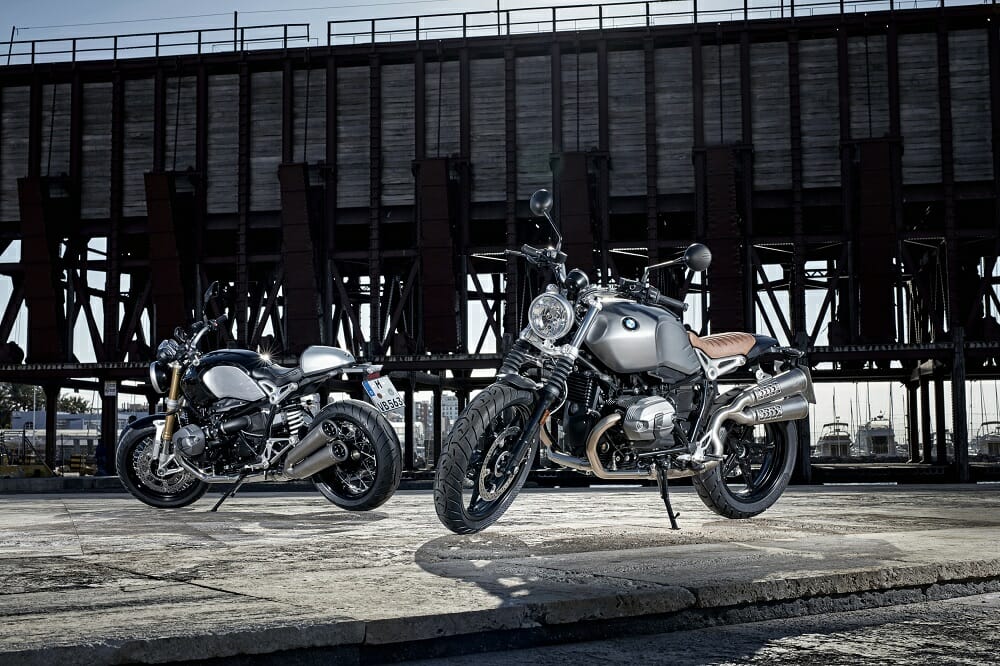
|
SPECIFICATIONS: 2017 BMW R nineT Scrambler |
|
|
Engine: |
Air/oil-cooled 2-cylinder boxer engine |
|
Displacement: |
1170cc |
|
Bore x stroke: |
101 x 73mm |
|
Horsepower: |
110 hp @ 7750 rpm (claimed) |
|
Torque: |
85 lb-ft @ 6000 rpm (claimed) |
|
Compression ratio: |
12.0:1 |
|
Fuel system: |
EFI with 50mm throttle boddies |
|
Exhaust: |
2 into 2 into 1 layout, two oxygen sensors, lateral single silencer with ECU-controlled bypass valve and integrated catalytic converter (Euro 4). |
|
Transmission: |
6-speed |
|
Chassis: |
Tubular space frame in steel, engine self-supporting |
|
Front suspension: |
43mm inverted forks. 125mm wheel travel. |
|
Rear suspension: |
Monoshock. 140mm wheel travel. |
|
Front brake: |
Dual 320mm discs. Brembo 4-piston calipers. ABS |
|
Rear brake: |
Single 265mm disc; Brembo two-piston caliper |
|
Front tire: |
120/70 ZR19 |
|
Rear tire: |
170/60 ZR17 |
|
Head angle: |
61.5° |
|
Trail: |
N/A |
|
Wheelbase: |
60.1 in. |
|
Seat height: |
32.2 in. |
|
O/A height: |
N/A |
|
O/A width: |
N/A |
|
O/A length: |
85.6 in. |
|
Fuel capacity: |
4.49 gal. |
|
Weight: |
485 lb. (wet, claimed). |
|
MSRP: |
TBA |
